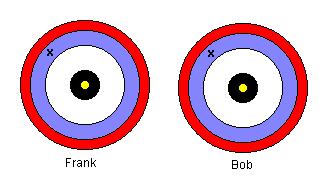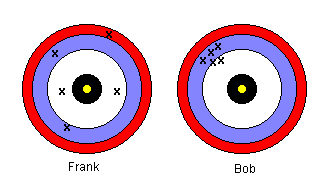Aim & PrecisionWhen using control charts, there is an important decision to be made between aim and precision. Later on in this module, we shall demonstrate why the most desirable state for any process is to be operating on target, with minimum variation. This means that the process average (the average value of the characteristic X for the entire output of the process) should be as close to the specified target value as possible, and only inherent, irreducible chance cause variation should be present. A common analogy used when discussing the difference between aim and precision is that of shooting at a target. Consider the case of two people, Frank and Bob, neither of whom is an accomplished marksman. They each fire a single shot which, by chance, hit about the same point on the target.  Judging by where their first shots landed, one might expect both men to adjust their aim down and to the right. This might be an appropriate course of action, but it is very difficult to tell from only a single piece of evidence. Consequently, the two men are persuaded to fire a further four shots without changing their aim. The results are shown below.  The difference between the two, which was not evident after the first shot, should be clear now. Frank's five shots are scattered randomly around the target with such a wide dispersal that any adjustment he makes in response to a single shot may well take his next shot further from the bull's-eye, perhaps missing the target altogether. Bob, on the other hand is consistently hitting about the same area of the target. His aim is not good, but the precision demonstrated in the clustering of his shots is such that it would be reasonable for him to adjust his aim down and to the right. The same thing is true in manufacturing processes. It will always be a mistake to adjust the process aim before there is clear evidence that the process is off target. Continual minor adjustments in response to single off-target values (known as hunting, or tampering), will almost always have the effect of increasing the overall variation in the process output. |